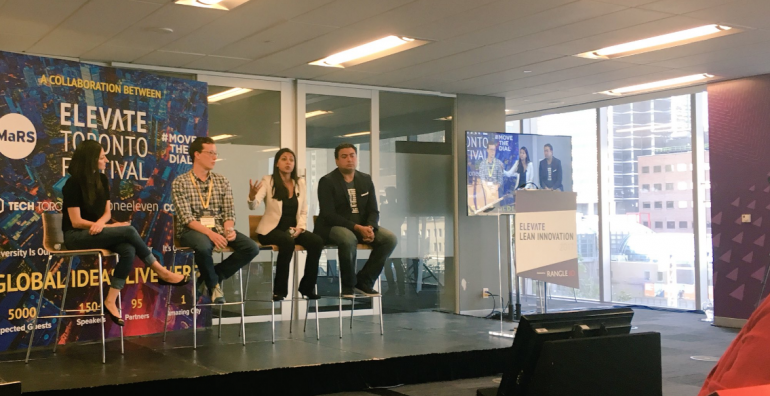In Toronto’s tech and business scene, “lean innovation” is more than just a trending topic. It’s a central tenet of doing business at scale.
When we launched Endy in 2015, ‘thinking like a startup’ was not a conscious choice – it was a reality of finite resources and fierce competition. Two years later, as the leading company of our kind in Canada, it’s more important now than ever to stay nimble as we grow. We’ve had to learn what countless other startups in growth mode know: it’s not easy being lean.
At Elevate Toronto’s inaugural tech festival, I joined more than 20 tech and business leaders to speak on the topic of lean innovation. From hiring quickly to adopting agile processes at every level of the organization, it’s never too early – or too late – to start thinking lean. Here are my top five takeaways from the day.
Test every assumption
My session at Elevate centred on the importance of using the scientific method as a framework for innovation. Before founding Endy, I worked as an engineer. The scientific method was an essential part of my job — and now, it’s even more so. If you haven’t heard the phrase since high school, it’s really quite simple. First, ask a question. Then hypothesize, test, observe, and analyze.
"Get out of the idea phase (what could I do) and more into action (what can I test)" – Mike Gettis, @EndySleep CEO #elevatetoronto pic.twitter.com/ZPvdJQJYLQ
— Rangle.io Inc. (@rangleio) September 13, 2017
Early entrepreneurs often get stuck on stage one. If there’s one piece of advice I can give, it’s to move out of the ‘idea’ phase and into the ‘action’ phase as quickly as possible. Don’t stew over finding the perfect product/market fit. Instead, do some research and develop a working theory. Then, define your variables and get to work, testing individual variables as cheaply as you can. Don’t get buried under the weight of “what ifs” – test until you’re confident in your business model. Then scale it.
Keep moving, and keep talking
While continually testing your assumptions is crucial, it’s even more important to analyze the results as a team to make meaningful improvements. Communication is central to lean innovation. The more siloed a team becomes, the less impact its tests will have on the whole.
"Context can kill even a great product … and sometimes companies ignore it completely!" @aprildunford #leaninnovation #elevatetoronto pic.twitter.com/yKid5kLuzy
— Rangle.io Inc. (@rangleio) September 13, 2017
This thought was shared by numerous speakers throughout the track, including Shawn Mandel, VP at TELUS Digital; and Todd Copeland, SVP of digital channels at TD, during their talk on Moving Fast in a Large Company. To encourage the free flow of information throughout an organization, divide larger teams into smaller groups with key stakeholders represented. Constant communication in small groups allows companies of all sizes to pivot and adapt to changing market needs, while minimizing spin.
Break up workflows, even at scale
Lean methodology is about more than maximizing value for customers while minimizing waste. Creating effective processes is easier in smaller teams, when there are fewer variables and less strain on the system. As your business grows, adding more people while keeping the same processes isn’t going to cut it. Avoid growing pains by continuously revisiting workflows: identify bottlenecks, split larger roles into smaller tasks, and ensure goals are measurable and clearly defined.
Paul Crowe, CEO of Symbility Intersect, made this point well in his talk on The People. The Process. The Tools. He conveyed the importance of using the right tools to get things done, and streamlining workflows with modularity and task management.
At its core, scaling your startup means you will have to learn to delegate. Entrepreneurs often take on the responsibility of managing several roles, acting as the “catch-all” for tasks that need to get done. Throughout the conference, numerous speakers made it clear that leaders need to get comfortable trusting others with important tasks – even if that means doing things differently.
Let the people you hire move you forward
As a company scales, it’s the CEO’s job to get out of the way. Mathili Mavinkurke, co-founder and COO of Sightline Innovation, put it best: “Adopting lean innovation at the corporate level means creating a sandbox for startups to collaborate.” To do this, it’s essential to have trust in your team — which means hiring the right people.
That’s where Farhan Thawar, co-founder and CTO of Helpful, took it away. If you’re curious about how to hire faster than a startup, here the core of Thawar’s talk: Hire for potential and evaluate based on performance, rather than experience. “The only way to evaluate a race car driver is to put them in the car. It’s the same with any talent.” Empower employees to make decisions and build as diverse a team as possible – “not to fill quotas,” but to win, said Thawar.
Empower employees to make decisions + avoid bias by evaluating performance, not resumes. #ElevateToronto @fnthawar pic.twitter.com/Cy1As4TsFl
— Delia (@delialoveless) September 13, 2017
Innovation is a culture, not a job title
During an afternoon panel, Mathili Mavinkurke, co-founder and COO of Sightline Innovation, made a point about innovation that is often overlooked: “Innovation has to be infiltrated into the organization at every level. You can’t just hire a ‘head of innovation’ or hold an innovation meeting,” and expect it to stick.
Innovation begins when employees at every level of the organization are rewarded for adopting agile workflows and taking creative, calculated risks, with measurable outputs. The larger an organization gets, the more difficult this becomes to implement. But as Ben Yoskovitz, founding partner of Highline BETA explained, “large companies are around because they ‘won’ at some point.” The challenge, he continued, is to continually innovate, and keep winning at scale – a chief innovation officer can’t do this alone.
Photo via Twitter


